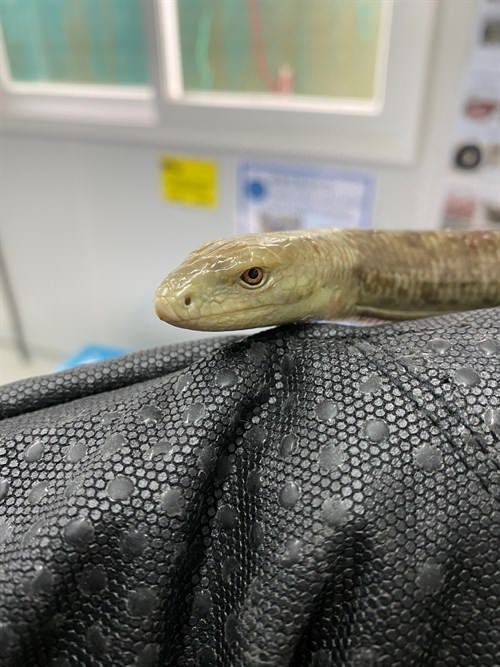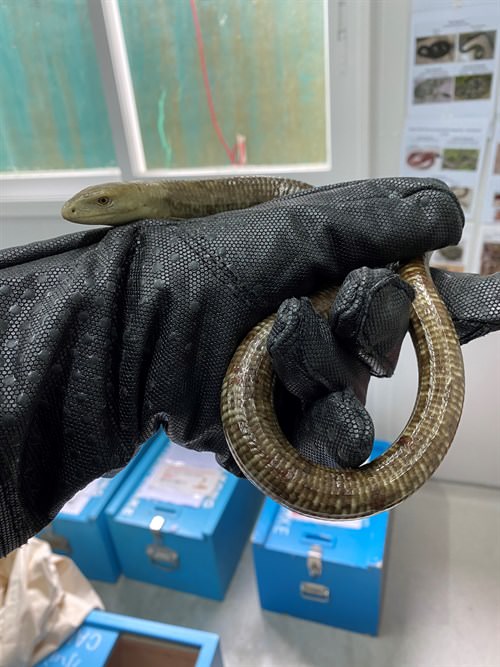This is a story about a lizard without legs
KFBG rescues many native wild animals, from the commonly seen Spotted Dove to the rarely seen King Cobra. On 6 March 2020, we received this interesting looking legless reptile through our Wild Snake Rescue Project. Wait! Do you mean… this is a snake? No! It actually happens to be a legless lizard, called the European Glass Lizard (Pseudopus apodus) or the Sheltopusik (Shell-A-pill-sik), which means ‘yellow-bellied’ in Russian. Unlike the two examples above it is not native to Hong Kong and demonstrates what our frontline animal experts have to sometimes deal with when processing the “stray-snake boxes”. The English common name of the Glass Lizard comes from their ability to not only break off their tail but also to ‘shatter’ it into smaller pieces to distract predators. Each piece moves confusing the would be predator with lots of choice and giving the lizard an opportunity to escape.


We commenced the Wild Snake Rescue Project in 1999 to mitigate human-snake conflict by providing an end point for snakes captured following Police call outs in Hong Kong. Snakes received by KFBG have generally strayed into human habitation and been subsequently captured by local snake catchers under the authority of the Police. Once at KFBG, snakes are identified to species level and subject to a physical check; native species are then released back to the wild in suitable habitats. On occasion we also receive other reptiles through this project; it was the first time the European Glass Lizard had been received at KFBG.
How do you distinguish a lizard from a snake? Look at its head!
Most lizards have legs but not always, we can use two other features on their head to distinguish between lizards and snakes. The European Glass Lizard, like other lizards, hasan ear-opening located on both sides of the head, and has eyelids and can blink (or wink at you if they want). Snakes, on the other hand, have ear bones connected to their jaws to detect vibration on the ground and low frequency sound in the air. Snakes do not blink, and they protect their eyes with clear scales which are attached to the rest of their epidermis (skin) and are replaced together with other scales during shedding.
The European Glass Lizard is a large legless lizard which can reach over a metre in length. It has lateral grooves (long slim dents along the sides of its body) and is a tan brown colour. This species is not native to Hong Kong, so the rescue team will find it a suitable home rather than release it to the wild. In this case it was recently re-homed via Hong Kong Society of Herpetology Foundation (HK Herp).
Exotic reptiles in Hong Kong
The European Glass Lizard is native to South-East Europe and the Middle East. This particular animal was found in a school at Ngau Tau Kok, an urban area of eastern Kowloon, far from its native range and differing immensely from its natural habitat of short grassland on which the snakes glide and especially love to hunt on rainy days for small mammals, insects, snails and slugs. This animal was most likely an escaped pet, which inadvertently found its way into the school grounds and was in a healthy condition when it was captured and brought to us.
Pet reptiles, like other pets, can escape from time to time – in the case of the European Glass Lizard this is probably an isolated event and unlikely to have caused any major impact to our native wildlife. Some escaped exotic pets, or unwanted pets that are deliberately released, can have a huge impact on our natural ecosystem. Species that are not native to Hong Kong can out-compete our native species; they can also harbour diseases that local species haven’t evolved to cope with and can cause sickness and death in our treasured native wildlife. If you have a pet that you no longer feel you can care for, don’t release it to the wild! In many cases your pet isn’t adapted to live in Hong Kong’s habitats and won’t know how to fend for itself. As well as cause suffering to your pet, it could lead to a number of negative impacts on our native wildlife.
Be careful if you decide to keep an exotic pet that the animal has originated from a legal source through captive breeding and is not a wild caught animal. If there is no demand then there is no supply. It is our responsibility as humans to care for the world around us and strive to live in harmony with nature in the choices that we make.

